I would like to create a horizontal ‘stacked bar’ type plot in which date runs along the x-axis and my samples appear as bars on the y-axis. In the simple example below, I have three samples (a, b, c) each containing three values (0, 1, 2). I would like the horizontal bar to be coloured based on the value at each time step along the x-axis, so that I end up with three horizontal bars (one for each sample) that run from my first to last time point and contain a series of blocks with colours that relate to the different values.
For example, say I want value 0 to be blue, value 1 to be yellow and value 2 to be red: for sample a, the first two days of the trace would be blue, then the next two days would be yellow, followed by a single blue and so on……
Example data:
df <- structure(list(date = c("30/04/2011", "01/05/2011", "02/05/2011", "03/05/2011", "04/05/2011", "05/05/2011", "06/05/2011", "07/05/2011", "08/05/2011", "09/05/2011", "10/05/2011", "11/05/2011", "12/05/2011", "13/05/2011", "14/05/2011", "15/05/2011", "16/05/2011", "17/05/2011", "18/05/2011", "19/05/2011", "20/05/2011", "21/05/2011", "22/05/2011", "23/05/2011", "24/05/2011", "25/05/2011", "26/05/2011", "27/05/2011", "28/05/2011", "29/05/2011", "30/05/2011", "31/05/2011", "01/06/2011", "02/06/2011", "03/06/2011", "04/06/2011", "05/06/2011", "06/06/2011", "07/06/2011", "08/06/2011", "09/06/2011", "10/06/2011", "11/06/2011", "12/06/2011", "13/06/2011", "14/06/2011", "15/06/2011", "16/06/2011", "17/06/2011", "18/06/2011", "19/06/2011", "20/06/2011", "21/06/2011", "22/06/2011", "23/06/2011", "24/06/2011", "25/06/2011", "26/06/2011", "27/06/2011", "28/06/2011", "29/06/2011", "30/06/2011", "01/07/2011", "02/07/2011", "03/07/2011", "04/07/2011", "05/07/2011", "06/07/2011", "07/07/2011", "08/07/2011", "09/07/2011", "10/07/2011", "11/07/2011", "12/07/2011", "13/07/2011", "14/07/2011", "15/07/2011", "16/07/2011", "17/07/2011", "18/07/2011", "19/07/2011", "20/07/2011", "21/07/2011", "22/07/2011", "23/07/2011", "24/07/2011"), a = c(0L, 0L, 1L, 1L, 0L, 1L, 0L, 0L, 0L, 1L, 0L, 0L, 0L, 1L, 0L, 0L, 0L, 0L, 0L, 0L, 0L, 0L, 0L, 0L, 0L, 0L, 0L, 2L, 2L, 2L, 2L, 2L, 2L, 2L, 2L, 2L, 2L, 2L, 2L, 2L, 2L, 2L, 2L, 2L, 2L, 2L, 2L, 2L, 2L, 0L, 0L, 0L, 0L, 0L, 0L, 0L, 0L, 0L, 0L, 0L, 0L, 1L, 1L, 1L, 1L, 0L, 0L, 0L, 1L, 1L, 0L, 0L, 0L, 1L, 1L, 0L, 1L, 0L, 0L, 0L, 0L, 0L, 0L, 0L, 0L, 1L), b = c(0L, 1L, 1L, 0L, 0L, 0L, 0L, 1L, 1L, 0L, 0L, 0L, 1L, 0L, 0L, 0L, 0L, 0L, 0L, 0L, 0L, 0L, 2L, 2L, 2L, 2L, 2L, 2L, 2L, 2L, 2L, 2L, 2L, 2L, 2L, 2L, 2L, 2L, 2L, 2L, 2L, 2L, 2L, 2L, 0L, 0L, 0L, 1L, 0L, 0L, 0L, 0L, 0L, 0L, 0L, 0L, 0L, 0L, 1L, 0L, 0L, 0L, 0L, 0L, 0L, 0L, 1L, 1L, 1L, 0L, 0L, 0L, 0L, 0L, 1L, 1L, 0L, 0L, 0L, 0L, 0L, 1L, 1L, 1L, 1L, 1L), c = c(1L, 1L, 0L, 0L, 0L, 1L, 0L, 1L, 0L, 1L, 0L, 1L, 0L, 0L, 0L, 0L, 0L, 0L, 0L, 0L, 0L, 0L, 0L, 0L, 0L, 2L, 2L, 2L, 2L, 2L, 2L, 2L, 2L, 2L, 2L, 2L, 2L, 2L, 2L, 2L, 2L, 2L, 2L, 2L, 2L, 2L, 2L, 2L, 2L, 2L, 2L, 2L, 2L, 2L, 2L, 0L, 0L, 0L, 0L, 0L, 0L, 0L, 0L, 0L, 0L, 0L, 0L, 0L, 0L, 0L, 0L, 1L, 0L, 0L, 0L, 0L, 0L, 0L, 0L, 1L, 1L, 1L, 0L, 0L, 0L, 0L)), .Names = c("date", "a", "b", "c"), class = "data.frame", row.names = c(NA, -86L))
head(df)
# date a b c
# 1 30/04/2011 0 0 1
# 2 01/05/2011 0 1 1
# 3 02/05/2011 1 1 0
# 4 03/05/2011 1 0 0
# 5 04/05/2011 0 0 0
This must be a really easy thing to achieve but I can’t get my head around it (i.e. bar plot doesn't seem to work for this). Any help would be appreciated. Thanks!



